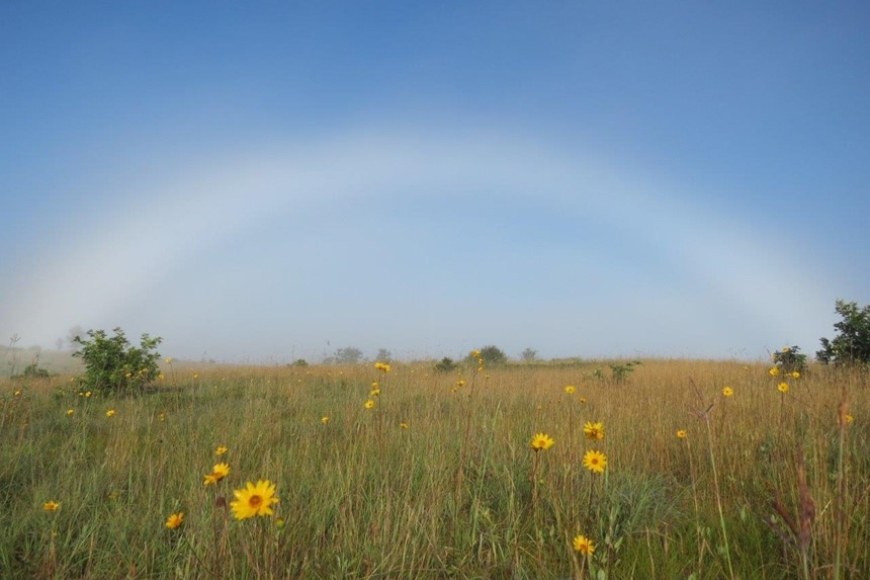Douglas County Wildlife Area
Douglas County Wildlife Area is located between Solon Springs and Gordon in Douglas County. It is locally known as “The Bird Sanctuary.” Find it 3 miles south of Solon Springs on Hwy 53 (or 3 miles north of Gordon on Hwy 53), west on County Road M about 3/4 mile, then northwest on Bird Road for about 1/4 mile to the information kiosk.
The property is approximately 4,005 acres of pine barrens habitat consisting of brush prairie, warm season grasslands, small seepage lakes and wetlands woven in a mosaic across rolling topography.
This variety of open landscapes provides excellent bird-watching opportunities, vistas while hiking the North County Trail and blueberry picking along an easily accessible trail system. An extensive horseback trail system can be accessed for day use from the department parking area or overnight use with a rental of the horse stables owned by Douglas County.
In April-May, there is a sharptailed grouse viewing blind available for reservation through the FOTBS to observe and photograph sharp-tailed grouse performing their spring mating rituals.
The county-owned clubhouse, located in the heart of the wildlife area, is available for large or small group day-use or overnight rental. The local Friends group offers unique accommodation at a cabin located at the foot of the Gordon Fire Tower, which they own and operate and make available for public viewing.
Friends Group
The Friends of the Bird Sanctuary Inc. was formed to work in partnership with the DNR to protect and preserve the Douglas County Wildlife Management Area. The group conducts education programs and other activities. Visit their website [exit DNR] for more information.
History
In 1925, the Northern States Amateur Field Trial Association (NSAFTA) conducted its first dog trial on land that would become the Douglas County Bird Sanctuary in 1935. NSAFTA held its first U.S. Chicken Champion Dog Trial in 1937. Trials continued until the early 2000s. When this trial began, prairie chickens were present on the property, giving the trials their name. Prairie chickens are no longer present in the area.
In 1947, the Wisconsin Conservation Commission established the "Douglas County Grouse Management Area." The property was used for research and experimental work on sharp-tailed grouse, prairie chickens and bobwhite quail. In 1948, the state entered into the first of several successive land leases with Douglas County.
The Wisconsin Conservation Department (precursor to the current Wisconsin DNR) negotiated an agreement with Douglas County to lease approximately 3,000 acres in 1953 to expand habitat management opportunities to promote the globally rare pine barrens habitats. The lease was renewed in 2003 for an additional 25 years. Unique to Douglas County, the lease is paid for by Pittman-Robertson funds, and the revenue is used by Douglas County to maintain the clubhouse and stables that were originally built by the dog-trialing groups nearly 100 years ago.
Management
The property is managed for a savanna-type plant community called pine barrens habitat. Savannas are plant communities dominated by grasses and interspersed with trees. In the pine barrens ecosystem, the shrub component is much more extensive than in other savanna types. Pine barrens are a transitional ecosystem between forest and prairie, born of fire and maintained by fire. While sharp-tailed grouse is a focus species of pine barrens habitat and a primary objective of this property, many other birds, plants and animals require or use this habitat type to meet their life cycle requirements.
Prescribed fire is the primary tool used to replicate natural disturbance that once occurred here. Mowing, occasional timber sales and fire break maintenance complement the burns and provide for safer and more effective burns. Horseback riding has a long history here, dating back to the original users, and the department maintains approximately 12 miles of horse trails across all areas of the property.
While all areas of the property are suitable for dispersed hiking, the North Country Trail offers premier hiking opportunities with several overlooks and a remote campsite on Rover’s Lake. The North Country Trail is maintained by local volunteers.
For more information on master planning for this and other wildlife areas around the state, visit the property planning page.
Importance Of Pine Barrens
Historically, pine barrens covered about 2,340,000 acres in Wisconsin and were found in four regions of the state. The northwestern Wisconsin pine barrens is an area of sandy soils approximately 12-15 miles wide and 125 miles long from the Sterling Barrens in Polk County in the southwest to the Moquah Barrens in the Bayfield peninsula to the northeast. These pine barrens have been divided into three geographic sections: the northeastern hill section, the pitted sand plain section and the southwestern marsh section.
Three major factors: fire, soils and topography dominate the development and maintenance of the pine barrens community. Humans have had a very large influence on the fire factor. Intensive control of fire has virtually eliminated the large, frequent fires that once naturally occurred in the pine barrens community. In the absence of fire, natural plant succession coupled with an intensive tree-planting program has turned almost all of Wisconsin's northwestern pine barrens into forest.
Today, there is less than one percent of the original pine barrens community remaining in Wisconsin. Most of the remaining pine barrens habitat in northwestern Wisconsin is found in four public wildlife management areas: Crex Meadows, Namekagon Barrens, Douglas County and Moquah Barrens. Pine barrens are an imperiled resource in Wisconsin. They are less common than many other habitat types, including wetlands and old-growth forests, which are universally recognized as scarce, valuable and meriting increased protection and management.
Recreation
The Douglas County Wildlife Area offers many recreational opportunities:
- Auto travel
- Birding
- Clubhouse*
- Cross-country skiing (no designated trail)
- Dog trials and training area
- Dog kennels*
- Horse trails
- Horse stables and corrals*
- Hiking (North Country Trail)
- Hunting
- Trapping
- Wild edibles/gathering
- Wildlife viewing
* Use of the clubhouse, horse stables and corrals, and dog kennels must be arranged through the Douglas County Forestry, Parks and Recreation Department, Solon Springs, 715-378-2219.
Amenities
- Bathroom – There are pit toilets located at both the county-owned Clubhouse and the horse stables.
- Parking lot – There is a large parking area located on Bird Road in the center of the property. This parking area accommodates six to eight vehicles or three vehicles with horse trailers.
- Campground and size – Camping is allowed at the county-owned Clubhouse and horse stables with an overnight rental. Camping is also allowed at the remote campsite along the North Country trail overlooking Rover’s Lake.
- Trails, Types and Lengths – The north country trail runs the entire length of the property from north to south, for approximately 4.25 miles.
Maps
Download [PDF] a map of this property.
If you are interested in exploring this property further, you can access an interactive map.
Useful Links
- Hunting
- Hunting regulations
- Trapping regulations
- Season dates and application deadlines
- Douglas County information [exit DNR]
- Douglas County Forestry, Parks And Recreation [exit DNR]
- Friends Of The Bird Sanctuary [exit DNR]
- Gordon Fire Tower And Cabin Rental [exit DNR]
- North County Trail: Brule-St. Croix Chapter [exit DNR]
- Wisconsin Department Of Tourism [exit DNR]


